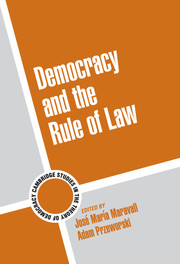Book contents
- Frontmatter
- Contents
- List of Contributors
- Acknowledgments
- Introduction
- Part I
- Part II
- Part III
- 9 Courts as an Instrument of Horizontal Accountability: The Case of Latin Europe
- 10 Rule of Democracy and Rule of Law
- 11 The Rule of Law as a Political Weapon
- 12 The Rule of Law and the Problem of Legal Reform in Michel de Montaigne's Essais
- Author Index
- Subject Index
9 - Courts as an Instrument of Horizontal Accountability: The Case of Latin Europe
Published online by Cambridge University Press: 09 November 2009
- Frontmatter
- Contents
- List of Contributors
- Acknowledgments
- Introduction
- Part I
- Part II
- Part III
- 9 Courts as an Instrument of Horizontal Accountability: The Case of Latin Europe
- 10 Rule of Democracy and Rule of Law
- 11 The Rule of Law as a Political Weapon
- 12 The Rule of Law and the Problem of Legal Reform in Michel de Montaigne's Essais
- Author Index
- Subject Index
Summary
Today, the traditional view according to which democracy implies majority rule in the form of parliamentary supremacy has come under growing criticism. In Europe since World War II, democratic regimes have increasingly incorporated substantive constraints to what the parliamentary majority can do. Not only must public authority be exerted within general rules, but citizens are deemed to be entitled to fundamental rights, whose exercise must remain outside the will of the majority. Therefore, submitting the performance of public functions to the scrutiny of independent judges becomes an effective and essential check on the exercise of political power, ensures the supremacy of the law, and guarantees citizens' rights (Stone 2000).
There is some ambiguity in the concept of judicial independence (Russell 2001). On one hand, judicial independence is understood as institutional independence, that is, as the guarantees judges enjoy vis-à-vis the political branches of government. On the other, the term refers to the behavior of the judges, that is, to their independence on the bench. However, if, as a rule, in order to behave independently, a judge needs to be independent from the parties at the case (and, therefore, also from the executive), it does not follow that institutionally independent judges will automatically behave in an independent way, a point to which we return later.
Historically, in democratic countries, the level of judicial independence as well as the role played by courts in the political system has varied.
- Type
- Chapter
- Information
- Democracy and the Rule of Law , pp. 223 - 241Publisher: Cambridge University PressPrint publication year: 2003
- 10
- Cited by



